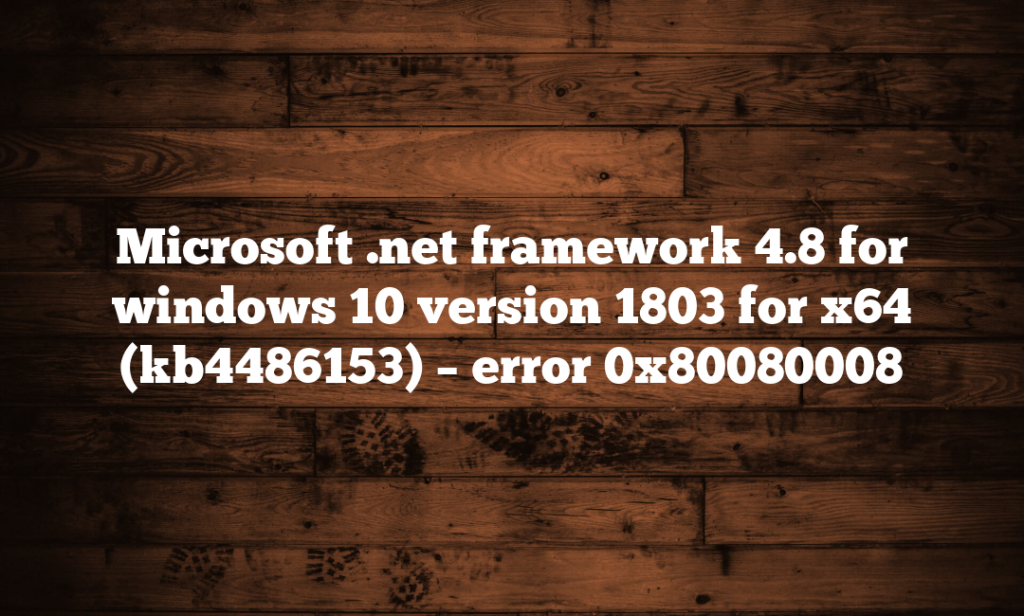Microsoft .net framework 4.8 for windows 10 version 1803 for x64 (kb4486153) – error 0x80080008
Encountering Error 0x80080008 within the Microsoft .NET Framework 4.8 can be a frustrating roadblock for users navigating the Windows 10 environment. This error often manifests during the installation or update process, hindering the seamless operation of crucial software built on the .NET Framework. However, understanding the root causes and employing effective troubleshooting strategies can lead to successful resolution.
Table of Contents
ToggleUnderstanding Error 0x80080008
Before delving into solutions, it’s vital to comprehend the nature of Error 0x80080008. This error code typically indicates a component registration issue within the system. When attempting to install or update the Microsoft .NET Framework 4.8, the system encounters difficulty in registering necessary components, leading to the failure represented by this error code.
Common Causes of Error 0x80080008
Several factors can contribute to the occurrence of Error 0x80080008:
- Corrupted System Files: System files essential for the proper functioning of the .NET Framework may become corrupted due to various reasons, such as malware infections, improper shutdowns, or disk errors.
- Incomplete Installation: If a previous installation or update process of the .NET Framework was interrupted or incomplete, it can leave behind inconsistencies that trigger error codes during subsequent installation attempts.
- Conflicting Software: Certain third-party software or security applications may interfere with the installation or functioning of the .NET Framework, leading to error occurrences.
- Outdated Drivers: Incompatibilities between system drivers and the .NET Framework can also result in error messages like 0x80080008.
Resolving Error 0x80080008: Step-by-Step Guide
Step 1: Perform System Reboot
A simple yet effective initial step is to reboot your system. This action can often clear temporary glitches or conflicts, allowing subsequent installation attempts to proceed smoothly.
Step 2: Run Windows Update Troubleshooter
Navigate to Settings > Update & Security > Troubleshoot and run the Windows Update Troubleshooter. This built-in tool can automatically detect and resolve common issues that may be preventing updates, including problems related to the .NET Framework.
Step 3: Check Disk Space Availability
Ensure that your system has sufficient disk space available for the installation or update process. Inadequate disk space can impede the extraction and installation of necessary files, leading to error messages.
Step 4: Temporarily Disable Antivirus Software
Sometimes, antivirus or security software can mistakenly flag legitimate processes associated with the .NET Framework as threats, causing installation errors. Temporarily disable your antivirus software before attempting the installation or update, and remember to re-enable it afterward.
Step 5: Perform SFC and DISM Scans
Run the System File Checker (SFC) and Deployment Imaging Servicing and Management (DISM) scans to identify and repair corrupted system files. Open Command Prompt as an administrator and execute the following commands sequentially:
sfc /scannow
DISM /Online /Cleanup-Image /RestoreHealth
Step 6: Clean Boot Your System
Perform a clean boot to minimize potential conflicts from third-party software. This involves starting your system with only essential services and startup programs enabled. Instructions for performing a clean boot can vary depending on your Windows version.
Step 7: Manually Install .NET Framework
If previous steps have not resolved the issue, consider manually installing the .NET Framework 4.8. Download the installer from the official Microsoft website and follow the on-screen instructions for installation.
Step 8: Update Device Drivers
Ensure that your system’s device drivers are up-to-date. Visit the manufacturer’s website or use third-party software to scan for and update outdated drivers that may be causing compatibility issues.
Conclusion
Navigating the troubleshooting process for Error 0x80080008 in Microsoft .NET Framework 4.8 demands patience and persistence. By following the steps outlined above and carefully addressing potential causes, users can overcome this hurdle and restore the functionality of their .NET Framework installations. Remember to stay vigilant for updates and system maintenance to prevent similar issues from recurring in the future.




